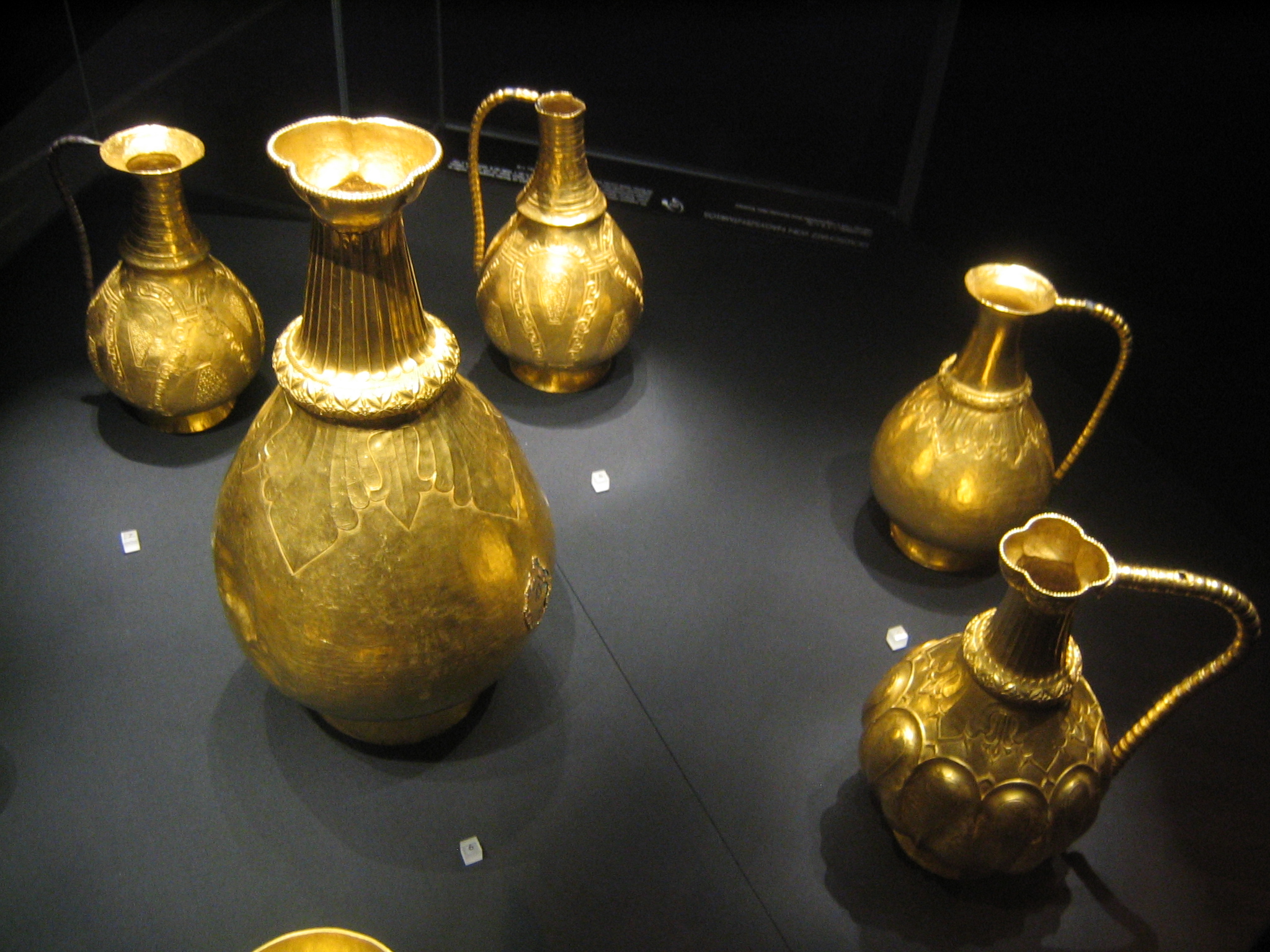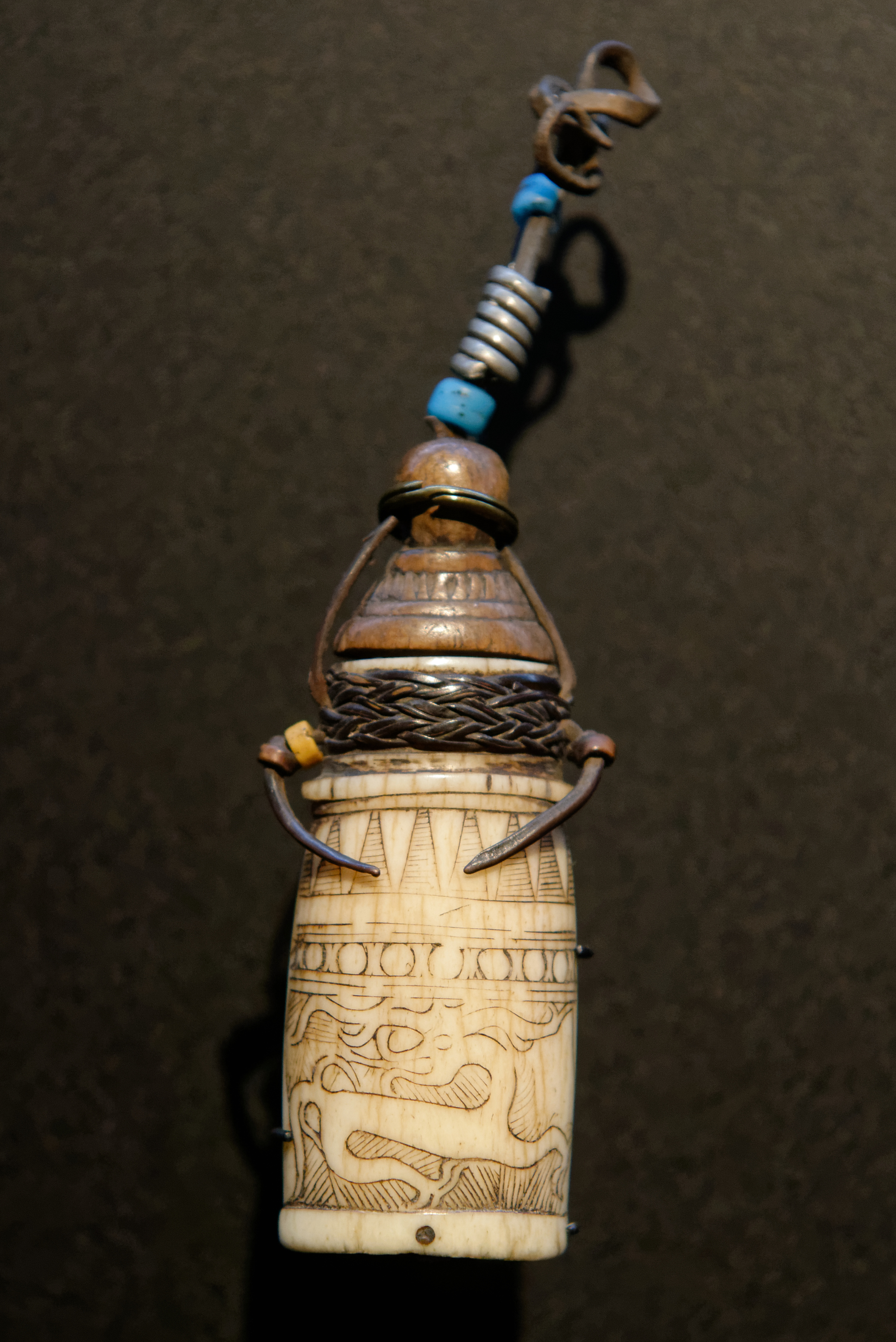|
Buyla
The Buyla inscription is a 9-word, 56-character inscription written in the Greek alphabet but in a non-Greek language. It is found on a golden buckled bowl or cup which is among the pieces of the Treasure of Nagyszentmiklós which are now in the Kunsthistorisches Museum in Vienna. The bowl is 12 cm in diameter and weighs 212 g, and has a handle or buckle, perhaps for hanging on a belt. The inscription is found around the outside of a circular design in the middle of the bowl. In the place where the inscription begins and ends, there is a cross. The inscription reads: . Prevailing opinion is that the language of the text is a Turkic language, and several translations have been proposed, but it has not been deciphered and the exact classification of the language has been a subject of debate. Vilhelm Thomsen translated the inscription: "Boila zoapan finished this bowl his drinking cup which Boutaoul zoapan made suitable for hanging up."according to Gyula László and István R� ... [...More Info...] [...Related Items...] OR: [Wikipedia] [Google] [Baidu] |
Treasure Of Nagyszentmiklós
The Treasure of Nagyszentmiklós ( hu, Nagyszentmiklósi kincs; german: Schatz von Nagyszentmiklós; ro, Tezaurul de la Sânnicolau Mare) is an important hoard of 23 early medieval gold vessels, in total weighing 9.945 kg (about 22 lbs), found in 1799 near Nagyszentmiklós, Kingdom of Hungary (german: Groß-Sankt-Niklaus, today Sânnicolau Mare, Romania), meaning "Great St Nicholas". After the excavation, the treasure was transferred to Vienna, the dynastic capital of the Habsburg Monarchy. Ever since, it has been in the possession of the Kunsthistorisches Museum there, where it is on permanent display. A wide range of views continue to be held as to the dating and the origins of the styles of the pieces, and the context in which they were made, which may well vary between the pieces. Unusually, the inscriptions on some pieces have increased the complexity of the arguments rather than reduced them. In 2008 Romanian officials asked the Austrian government for the treas ... [...More Info...] [...Related Items...] OR: [Wikipedia] [Google] [Baidu] |
Avars (Carpathians)
The Pannonian Avars () were an alliance of several groups of Eurasian nomads of various origins. The peoples were also known as the Obri in chronicles of Rus, the Abaroi or Varchonitai ( el, Βαρχονίτες, Varchonítes), or Pseudo-Avars in Byzantine sources, and the Apar ( otk, 𐰯𐰺) to the Göktürks (). They established the Avar Khaganate, which spanned the Pannonian Basin and considerable areas of Central and Eastern Europe from the late 6th to the early 9th century. The name Pannonian Avars (after the area in which they settled) is used to distinguish them from the Avars of the Caucasus, a separate people with whom the Pannonian Avars might or might not have had links. Although the name ''Avar'' first appeared in the mid-5th century, the Pannonian Avars entered the historical scene in the mid-6th century, on the Pontic–Caspian steppe as a people who wished to escape the rule of the Göktürks. They are probably best known for their invasions and destruction ... [...More Info...] [...Related Items...] OR: [Wikipedia] [Google] [Baidu] |
Aranca River
The Aranca or Zlatica (Romanian: ''Aranca'', Serbian: Златица / ''Zlatica'', Hungarian: ''Aranka'') is a 117 km long river in the Banat region of Romania and Serbia, left tributary of the river Tisa. Hydronymy The Serbian and Hungarian names of the river carry the meaning the ''golden river''. Course The Aranca originates in the northern part of the Banat, near the village Sânpetru German, southwest of the city of Arad, Romania. e-calauza.ro It flows to the west, next to the large villages of , , the town of |
Hungary
Hungary ( hu, Magyarország ) is a landlocked country in Central Europe. Spanning of the Carpathian Basin, it is bordered by Slovakia to the north, Ukraine to the northeast, Romania to the east and southeast, Serbia to the south, Croatia and Slovenia to the southwest, and Austria to the west. Hungary has a population of nearly 9 million, mostly ethnic Hungarians and a significant Romani minority. Hungarian, the official language, is the world's most widely spoken Uralic language and among the few non- Indo-European languages widely spoken in Europe. Budapest is the country's capital and largest city; other major urban areas include Debrecen, Szeged, Miskolc, Pécs, and Győr. The territory of present-day Hungary has for centuries been a crossroads for various peoples, including Celts, Romans, Germanic tribes, Huns, West Slavs and the Avars. The foundation of the Hungarian state was established in the late 9th century AD with the conquest of the Carpat ... [...More Info...] [...Related Items...] OR: [Wikipedia] [Google] [Baidu] |
Békés County
Békés (, , ro, Județul Bichiș) is an administrative division (county or ''megye'') in south-eastern Hungary, on the border with Romania. It shares borders with the Hungarian counties Csongrád, Jász-Nagykun-Szolnok, and Hajdú-Bihar. The capital of Békés county is Békéscsaba. The county is also part of the Danube-Kris-Mures-Tisa euroregion. Etymology In Slovak, it is known as ''Békešská župa'' and in Romanian as ''Județul Bichiș''. After Hungarians conquered the area, Békés and its surroundings were the property of the '' Csolt'' clan. Békés (the name means "peaceful") was originally the name of the castle which gave its name to the comitatus, and, like many castles, was possibly named after its first steward. Geography This county has a total area of – 6.05% of Hungary. Békés County lies on the Pannonian Plain (Great Plain) and is a flat area with good soil. The average rainfall is 645 mm per year. One-fifth of the natural gas resources of ... [...More Info...] [...Related Items...] OR: [Wikipedia] [Google] [Baidu] |
Szarvas
Szarvas (; sk, Sarvaš; german: Sarwasch) is a town in Békés County, Hungary. Name Placename Szarvas originated from the old Hungarian word ''szarvas'', which means deer. Deer also can be found in the coat of arms of the town. Location Szarvas is located in the Great Hungarian Plain upon the Körös River, southeast from Budapest. Highways 44 and 443, and the Mezőtúr-Orosháza- Mezőhegyes railway line also cross the town. The geographic centre of Hungary was near Szarvas before the Treaty of Trianon; a memorial in a windmill shape now marks that location in a park on a bank of the Körös River across from the Arboretum. History According to the Hungarian Royal Treasury ( hu, Magyar Királyi Kincstár) it was an ethnic Hungarian town in 1495.Károly Kocsis (DSc, University of Miskolc) – Zsolt Bottlik (PhD, Budapest University) – Patrik Tátrai: Etnikai térfolyamatok a Kárpát-medence határon túli régióiban, Magyar Tudományos Akadémia (Hungarian ... [...More Info...] [...Related Items...] OR: [Wikipedia] [Google] [Baidu] |
Cemetery
A cemetery, burial ground, gravesite or graveyard is a place where the remains of dead people are buried or otherwise interred. The word ''cemetery'' (from Greek , "sleeping place") implies that the land is specifically designated as a burial ground and originally applied to the Roman catacombs. The term ''graveyard'' is often used interchangeably with cemetery, but a graveyard primarily refers to a burial ground within a churchyard. The intact or cremated remains of people may be interred in a grave, commonly referred to as burial, or in a tomb, an "above-ground grave" (resembling a sarcophagus), a mausoleum, columbarium, niche, or other edifice. In Western cultures, funeral ceremonies are often observed in cemeteries. These ceremonies or rites of passage differ according to cultural practices and religious beliefs. Modern cemeteries often include crematoria, and some grounds previously used for both, continue as crematoria as a principal use long after the intermen ... [...More Info...] [...Related Items...] OR: [Wikipedia] [Google] [Baidu] |
Needlecase
A needlecase or needle case is a small, often decorative, holder for sewing needles. Early needlecases were usually small tubular containers of bone, wood, or bronze with tight-fitting stoppers, often designed to hang from a belt. Needlecases are sometimes called by the French name '' étui'' and are typically one of the tools attached to a chatelaine. A pin poppet is a similar container for pins, common in the 18th century. History Early sewing needles were precious items and easily lost. Needlecases were a necessity for storing these fragile objects, and are found in cultures around the world. Tubular bronze needlecases are common finds from Viking-age sites in Europe. Cane needlecases were found in a grave from Cerro Azul, Peru, dated to 1000–1470 AD. Bone, leather and metal needlecases have been found from Medieval London, and bone or ivory needlecases were made by Inuit. Bone and ivory needlecases and pin poppets were also popular in 18th century America. Elaborate needle ... [...More Info...] [...Related Items...] OR: [Wikipedia] [Google] [Baidu] |
Sewing Needle
A sewing needle, used for hand-sewing, is a long slender tool with a pointed tip at one end and a hole (or ''eye'') to hold the sewing thread. The earliest needles were made of bone or wood; modern needles are manufactured from high carbon steel wire and are nickel- or 18K gold-plated for corrosion resistance. High quality embroidery needles are plated with two-thirds platinum and one-third titanium alloy. Traditionally, needles have been kept in needle books or needlecases which have become objects of adornment. Sewing needles may also be kept in an étui, a small box that held needles and other items such as scissors, pencils and tweezers. Types of hand sewing needles Hand sewing needles come in a variety of types/classes designed according to their intended use and in a variety of sizes within each type. * Sharp needles: used for general hand sewing; built with a sharp point, a round eye, and are of medium length. Those with a double-eyes are able to carry two strands ... [...More Info...] [...Related Items...] OR: [Wikipedia] [Google] [Baidu] |
Szarvas Inscription
The Szarvas inscription refers to the inscription on a bone needle case found near Szarvas in southeastern Hungary and dating from the second half of the 8th century, the " Late Avar" period (700-791). The needle case and its inscription The name of the script of the Szarvas inscription The Hungarian archeologist, historian and linguist Gábor Vékony named the script used on the needle case as ''"Kárpát-medencei rovásírás"'' ("Carpathian Basin Rovas script"). He often used this term in his book, ''A székely írás emlékei, kapcsolatai, története'', e.g. in the chapter ''"A kárpát-medencei rovásábécé korabeli feljegyzése"'' ("The contemporary record of the Carpathian Basin Rovas alphabet"). Vékony analysed the similarities and the differences between the Old Hungarian and the Carpathian Basin scripts on page 154 of his book. On page 232, Vékony wrote: ''"- Aethicus Ister jelei azonosak az egykori Kárpát-medencei rovásírás jeleivel."'' ("The symbols of ... [...More Info...] [...Related Items...] OR: [Wikipedia] [Google] [Baidu] |
Turkic Runes
The Old Turkic script (also known as variously Göktürk script, Orkhon script, Orkhon-Yenisey script, Turkic runes) was the alphabet used by the Göktürks and other early Turkic khanates from the 8th to 10th centuries to record the Old Turkic language.Scharlipp, Wolfgang (2000). ''An Introduction to the Old Turkish Runic Inscriptions''. Verlag auf dem Ruffel, Engelschoff. . The script is named after the Orkhon Valley in Mongolia where early 8th-century inscriptions were discovered in an 1889 expedition by Nikolai Yadrintsev. These Orkhon inscriptions were published by Vasily Radlov and deciphered by the Danish philologist Vilhelm Thomsen in 1893. This writing system was later used within the Uyghur Khaganate. Additionally, a Yenisei variant is known from 9th-century Yenisei Kirghiz inscriptions, and it has likely cousins in the Talas Valley of Turkestan and the Old Hungarian alphabet of the 10th century. Words were usually written from right to left. Origins Many scien ... [...More Info...] [...Related Items...] OR: [Wikipedia] [Google] [Baidu] |







